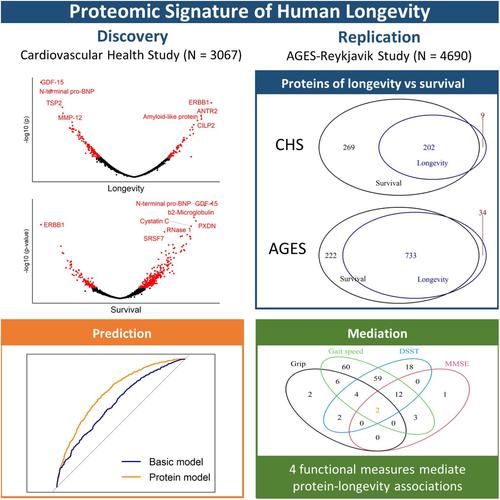当前位置:
X-MOL 学术
›
Aging Cell
›
论文详情
Our official English website, www.x-mol.net, welcomes your feedback! (Note: you will need to create a separate account there.)
Plasma proteomic signature of human longevity
Aging Cell ( IF 7.8 ) Pub Date : 2024-03-05 , DOI: 10.1111/acel.14136 Xiaojuan Liu 1 , Gisli Thor Axelsson 2, 3 , Anne B. Newman 4 , Bruce M. Psaty 5, 6, 7 , Robert M. Boudreau 4 , Chenkai Wu 8 , Alice M. Arnold 9 , Thor Aspelund 2, 3 , Thomas R. Austin 10 , Julius M. Gardin 11 , Kristin Siggeirsdottir 3, 12 , Russell P. Tracy 13, 14 , Robert E. Gerszten 15 , Lenore J. Launer 16 , Lori L. Jennings 17 , Vilmundur Gudnason 2, 3 , Jason L. Sanders 18 , Michelle C. Odden 1, 19
Aging Cell ( IF 7.8 ) Pub Date : 2024-03-05 , DOI: 10.1111/acel.14136 Xiaojuan Liu 1 , Gisli Thor Axelsson 2, 3 , Anne B. Newman 4 , Bruce M. Psaty 5, 6, 7 , Robert M. Boudreau 4 , Chenkai Wu 8 , Alice M. Arnold 9 , Thor Aspelund 2, 3 , Thomas R. Austin 10 , Julius M. Gardin 11 , Kristin Siggeirsdottir 3, 12 , Russell P. Tracy 13, 14 , Robert E. Gerszten 15 , Lenore J. Launer 16 , Lori L. Jennings 17 , Vilmundur Gudnason 2, 3 , Jason L. Sanders 18 , Michelle C. Odden 1, 19
Affiliation

|
The identification of protein targets that exhibit anti‐aging clinical potential could inform interventions to lengthen the human health span. Most previous proteomics research has been focused on chronological age instead of longevity. We leveraged two large population‐based prospective cohorts with long follow‐ups to evaluate the proteomic signature of longevity defined by survival to 90 years of age. Plasma proteomics was measured using a SOMAscan assay in 3067 participants from the Cardiovascular Health Study (discovery cohort) and 4690 participants from the Age Gene/Environment Susceptibility‐Reykjavik Study (replication cohort). Logistic regression identified 211 significant proteins in the CHS cohort using a Bonferroni‐adjusted threshold, of which 168 were available in the replication cohort and 105 were replicated (corrected p value <0.05). The most significant proteins were GDF‐15 and N‐terminal pro‐BNP in both cohorts. A parsimonious protein‐based prediction model was built using 33 proteins selected by LASSO with 10‐fold cross‐validation and validated using 27 available proteins in the validation cohort. This protein model outperformed a basic model using traditional factors (demographics, height, weight, and smoking) by improving the AUC from 0.658 to 0.748 in the discovery cohort and from 0.755 to 0.802 in the validation cohort. We also found that the associations of 169 out of 211 proteins were partially mediated by physical and/or cognitive function. These findings could contribute to the identification of biomarkers and pathways of aging and potential therapeutic targets to delay aging and age‐related diseases.
中文翻译:

人类长寿的血浆蛋白质组学特征
具有抗衰老临床潜力的蛋白质靶点的鉴定可以为延长人类健康寿命的干预措施提供信息。大多数以前的蛋白质组学研究都集中在实际年龄而不是寿命上。我们利用两个基于大规模人群的长期随访前瞻性队列来评估长寿的蛋白质组特征,即生存至 90 岁。使用 SOMAscan 测定法对来自心血管健康研究(发现队列)的 3067 名参与者和来自年龄基因/环境易感性-雷克雅未克研究(复制队列)的 4690 名参与者进行血浆蛋白质组学测量。Logistic 回归使用 Bonferroni 调整阈值确定了 CHS 队列中的 211 个显着蛋白,其中 168 个可在复制队列中使用,105 个被复制(校正)p 值<0.05)。两个队列中最重要的蛋白质是 GDF-15 和 N 端 BNP 前体。使用 LASSO 通过 10 倍交叉验证选择的 33 种蛋白质构建了基于蛋白质的简约预测模型,并使用验证队列中的 27 种可用蛋白质进行了验证。该蛋白质模型的性能优于使用传统因素(人口统计、身高、体重和吸烟)的基本模型,发现队列中的 AUC 从 0.658 提高到 0.748,验证队列中的 AUC 从 0.755 提高到 0.802。我们还发现 211 种蛋白质中有 169 种的关联部分是由身体和/或认知功能介导的。这些发现可能有助于识别衰老的生物标志物和途径以及延缓衰老和年龄相关疾病的潜在治疗靶点。
更新日期:2024-03-05
中文翻译:

人类长寿的血浆蛋白质组学特征
具有抗衰老临床潜力的蛋白质靶点的鉴定可以为延长人类健康寿命的干预措施提供信息。大多数以前的蛋白质组学研究都集中在实际年龄而不是寿命上。我们利用两个基于大规模人群的长期随访前瞻性队列来评估长寿的蛋白质组特征,即生存至 90 岁。使用 SOMAscan 测定法对来自心血管健康研究(发现队列)的 3067 名参与者和来自年龄基因/环境易感性-雷克雅未克研究(复制队列)的 4690 名参与者进行血浆蛋白质组学测量。Logistic 回归使用 Bonferroni 调整阈值确定了 CHS 队列中的 211 个显着蛋白,其中 168 个可在复制队列中使用,105 个被复制(校正)



























 京公网安备 11010802027423号
京公网安备 11010802027423号